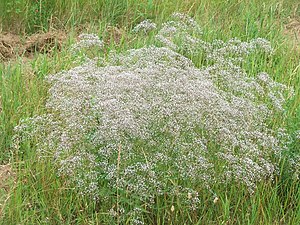Panicle of gypsophila
| Panicle of gypsophila | ||||||||||||
|---|---|---|---|---|---|---|---|---|---|---|---|---|

Panicle of gypsophila ( Gypsophila paniculata ) |
||||||||||||
| Systematics | ||||||||||||
|
||||||||||||
| Scientific name | ||||||||||||
| Gypsophila paniculata | ||||||||||||
| L. |
The Rispige gypsophila ( Gypsophila paniculata ) also panicles gypsum herb and veil gypsum herb , horticultural 's breath is a plant of the family Pink family (Caryophyllaceae). The species is cultivated as an ornamental plant.

description
Rispige gipskraut is a perennial , herbaceous plant and reaches stature heights of 50 to 90 cm. It forms a beet-like thickened root up to 2.4 m in length. The stems stand upright and are bare, only at the base they are covered with soft glandular hairs. The leaves are 20 to 70 mm long, 2.5 to 10 mm wide, lanceolate in shape and sharply pointed.
The inflorescence is a loose, multi-flowered panicle that is hairy or glabrous. The individual flowers have a diameter of around 4 mm. The calyx is 1.5 to 2 mm long, the calyx teeth are egg-shaped and blunt. The petals are 3 to 4 mm long, rounded at the front and white, rarely pink. The stamens are longer than the crown. The flowers are mostly hermaphrodite and proterandric . The pollination is done by insects, mainly by Diptera and Hymenoptera . Flowering time is June to September.
The capsules are 3 to 5 mm long and rounded. The seeds have blunt humps. The plant is a steppe roller .
The number of chromosomes is 2n = 28, 34.
distribution
Rispige gipskraut is native from Central, Eastern and Southeast Europe to West Siberia and Mongolia. It is a neophyte in North and South America, Australia and New Zealand. In Central Europe, the natural occurrences reach as far as Vienna and Marchfeld (Lower Austria) and South Moravia. It is often planted in gardens and rarely grows wild in Central Europe, for example in Mecklenburg-Western Pomerania, Brandenburg, Baden-Württemberg and South Tyrol.
It grows in sandy steppes and on sandy hills. It also occurs overgrown in dry sand grassland, on rubble and along railway and embankments. It is limited to the colline altitude level .
Similar species
The two common types of gypsophila in Germany are the upright gypsophila (Gypsophila paniculata) and the creeping gypsophila (Gypsophila repens) . The gypsophila originally grows in the Canadian Rocky Mountains , where it reaches a height of up to 1.20 meters. It was once considered a weed by the farmers and controlled. In our gardens it grows about 1 meter high and has several small white and pink flowers in a panicle. Creeping gypsophila, also known as carpet gypsophila, is at home in the Alps and Pyrenees .
use
Rispige gipskraut is cultivated as an ornamental plant. In the past, the saponin-rich roots were used as soap roots and the plants were cultivated for this.
literature
- Manfred A. Fischer , Karl Oswald, Wolfgang Adler: Excursion flora for Austria, Liechtenstein and South Tyrol. 3rd, improved edition. State of Upper Austria, Biology Center of the Upper Austrian State Museums, Linz 2008, ISBN 978-3-85474-187-9 .
- Siegmund Seybold (Ed.): Schmeil-Fitschen interactive (CD-Rom), Quelle & Meyer, Wiebelsheim 2001/2002, ISBN 3-494-01327-6
Individual evidence
- ↑ a b Gypsophila in the Germplasm Resources Information Network (GRIN), USDA , ARS , National Genetic Resources Program. National Germplasm Resources Laboratory, Beltsville, Maryland. Retrieved September 5, 2017.
- ↑ Cf. Heimat.de (no year): GRASSWORK PLANTS AND PFLEGEN , accessed on June 9, 2016
Web links
- Panicle of gypsophila. In: FloraWeb.de.
- Distribution map for Germany. In: Floraweb .
- Gypsophila paniculata L. In: Info Flora , the national data and information center for Swiss flora . Retrieved October 8, 2015.
- Distribution in the northern hemisphere according to Eric Hultén
- Thomas Meyer: Data sheet with identification key and photos at Flora-de: Flora von Deutschland (old name of the website: Flowers in Swabia )
- Institute for Pharmacy at the University of Mainz on Gypsophila paniculata
